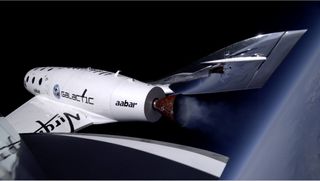Virgin Galactic to Fly 12 Space Tech Experiments on Private Spaceliner

As Virgin Galactic prepares to carry paying tourists into space, it's also readying another source of flight cash: carrying tech experiments designed for microgravity.
NASA and the private company announced that Virgin will fly 12 technology experiments on the first commercial research flight of SpaceShipTwo, which has undergone several powered test flights in the past year.
"The payloads on this flight represent a cross-section of promising space exploration technologies that could benefit future NASA missions," Christopher Baker, the flight opportunities program manager at NASA's Armstrong Flight Research Center, said in a statement. [The Top 10 Private Spaceships]
There will be a mix of experiments from NASA, universities and commercial companies flying aboard, testing concepts ranging from fluid behavior to 3D printer improvements.
The selected experiments are:
- On-Orbit Propellant Storage Stability: A prototype "orbiting fuel depot" to help power future space missions. (Embry-Riddle Aeronautical University)
- Electromagnetic Field Measurements: Determining what the electromagnetic field is like inside of a spacecraft, to reduce interference for future experiments. (John Hopkins University Applied Physics)
- Collisions Into Dust: Investigators reproduce a meteor impact on to simulated regolith (lifeless soil) to see how fine particles behave in microgravity after a collision. This will better inform future missions on airless moons or asteroids. (University of Central Florida)
- Validating Telemetric Imaging Hardware for Crew-Assisted and Crew-Autonomous Biological Imaging: Determining the use of biological fluorescent imaging to see how "biological entites" cope with spaceflight. (University of Florida)
- Variable Radiator: Watching how fluids behave in a "spacecraft thermal energy rejection solution", with the aim of improving spacecraft radiators or other systems that rely on fluids to work. (Texas A&M University, in partnership with Advanced Cooling Technologies and Jet Learning Laboratory)
- Micro Satellite Attitude Control System: Will examine how a twist of the wrist can control small satellites, perhaps improving their pointing precision. (State University of New York)
- Saturated Fluid Pistonless Pump Technology Demonstrator: A system that can pump fuel without the need of a turbo, which could be a lighter solution to flying fuel systems in space. (University of Colorado and Flometrics, Inc,)
- Automatic Dependent Surveillance-Broadcast (ADS-B) Transmitter: A device that tracks and broadcasts location, and is used in air traffic control systems. This particular version could be used for suborbital reusable launch vehicles and stratospheric balloons. (MITRE Corp. and Embry-Riddle Aeronautical University, with sponsorship from the Federal Aviation Administration)
- 3D printing: An "advanced manufacturing experiment" intended to improve 3-D printing in space. (Made in Space, Inc.)
- Facility for Microgravity Research and Submicroradian Stabilization: A system that is intended to better isolate experiments from vibrations in microgravity. (Controlled Dynamics, Inc.)
- Suborbital Flight Environment Monitor: An array of sensors to track flight accelerations. (NASA Ames Research Center)
- Multi-Phase Flow Experiment for Suborbital Testing: A "passive gas and liquid separator" that could be used for water purification, among other applications. (NASA Johnson Space Center)
Learn more about the experiments via NASA: http://www.nasa.gov/ames/nasa-virgin-galactic-announce-payloads-for-spaceshiptwo-flight/#.U5YpRpSwI72
Follow Elizabeth Howell @howellspace. Follow us @Spacedotcom, Facebook and Google+. Original article on Space.com.
Get the Space.com Newsletter
Breaking space news, the latest updates on rocket launches, skywatching events and more!
Join our Space Forums to keep talking space on the latest missions, night sky and more! And if you have a news tip, correction or comment, let us know at: community@space.com.

Elizabeth Howell (she/her), Ph.D., is a staff writer in the spaceflight channel since 2022 covering diversity, education and gaming as well. She was contributing writer for Space.com for 10 years before joining full-time. Elizabeth's reporting includes multiple exclusives with the White House and Office of the Vice-President of the United States, an exclusive conversation with aspiring space tourist (and NSYNC bassist) Lance Bass, speaking several times with the International Space Station, witnessing five human spaceflight launches on two continents, flying parabolic, working inside a spacesuit, and participating in a simulated Mars mission. Her latest book, "Why Am I Taller?", is co-written with astronaut Dave Williams. Elizabeth holds a Ph.D. and M.Sc. in Space Studies from the University of North Dakota, a Bachelor of Journalism from Canada's Carleton University and a Bachelor of History from Canada's Athabasca University. Elizabeth is also a post-secondary instructor in communications and science at several institutions since 2015; her experience includes developing and teaching an astronomy course at Canada's Algonquin College (with Indigenous content as well) to more than 1,000 students since 2020. Elizabeth first got interested in space after watching the movie Apollo 13 in 1996, and still wants to be an astronaut someday. Mastodon: https://qoto.org/@howellspace
